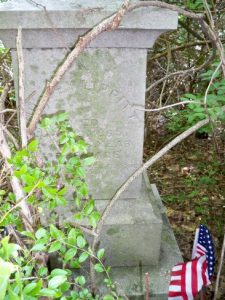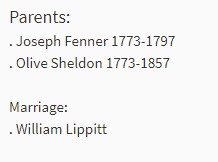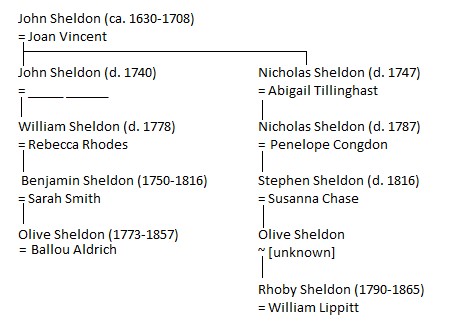
One way genealogies can get items incorrect is when there are two individuals of roughly the same age with the same name and who have other identifying relatives with the same name as well. In this example, it gets further muddled as their respective fathers died in the same year.
The focus of this research was Rhobe (or Rhoby) Sheldon (1790–1865) of Cranston, Rhode Island, wife of William Lippitt (1786–1872). Rhoby and William married at Cranston on 1 January 1809. Their marriage, like most for this time period, does not list the parents of either, only that they were both residents of Cranston. Rhoby and William had twelve children, and Rhoby died at Cranston 3 January 1865. Her death record stated that she was born in Cranston and was the daughter of Stephen Sheldon. Maybe that’s where I should have left this; after all, her parents were not the focus of the genealogy…
 Rhoby’s Findagrave memorial listed the following interesting item in regards to her parents:
Rhoby’s Findagrave memorial listed the following interesting item in regards to her parents:
This wasn’t sourced, but it piqued my curiosity. (The contributor to this memorial was not accepting messages.) All records I had seen listed Rhoby as a Sheldon. The Joseph Fenner listed above was the son of Rhode Island Governor Arthur Fenner (1745–1805). I could not find any legitimate sources that claimed Arthur’s son Joseph had a child – or even was married. Was Rhoby Sheldon illegitimate? I then looked for her purported mother Olive Sheldon.
The dates on the above findagrave entry pointed to an Olive Sheldon, born at Smithfield, Rhode Island 9 May 1773, daughter of Benjamin and Sarah (Smith) Sheldon. This Olive also had a brother named Stephen, so if Rhoby was Olive’s child, perhaps this uncle raised Rhoby. Benjamin Sheldon moved to Norwich, Chenango County, New York, where he died in 1816. His will mentioned a daughter Olive Aldrich, but no granddaughter Rhoby (not that it necessarily would). I looked through some records back in Smithfield, but did not find anything great.
I looked at The Sheldon Magazine (written in the 1850s), and this is where things got confusing. There was also a Stephen Sheldon (a second cousin to Benjamin, see chart below), who had a daughter named Olive, and also died in the year 1816! This work had further information on Benjamin (of Cranston, like Rhoby), and had his daughter Olive (no spouse attributed) with a child “Rhoda” married to “Lippitt.” The fact that this report did not list Olive’s spouse (or Rhoda’s husband’s first name) led me to conclude this was likely from a will or deed. Going to Cranston probate records, I found the will of Stephen Sheldon, written in 1814 and proved two years later. Sure enough the fourth item is as follows:
Fourthly, I do give unto my daughter Olive’s Heir, Rhobe Lippitt two hundred Dollars to be paid by my Executor, hereafter named, in one year, after my decease.
 There was Rhoby! So Rhobe Sheldon was the illegitimate daughter of Olive Sheldon, who was the daughter of Stephen and Susanna (Chace) Sheldon of Cranston. Whether this Olive ever married, or when she died, is not known. As Stephen Sheldon was Rhoby’s maternal grandfather, perhaps he helped raise her, which could be a reason he was listed as her father on Rhoby’s death. I have found nothing to support the above claim that Rhoby’s father was Joseph Fenner, and since the above findagrave entry had the wrong Olive, I’ll let that rest for now and leave Rhoby’s father as unknown. Even though the initial facts were off, they led to this additional clarification. Having the wrong Olive listed is not surprising, since they were around the same age, both had immediate relatives named Stephen, and both had fathers who died in the same year!
There was Rhoby! So Rhobe Sheldon was the illegitimate daughter of Olive Sheldon, who was the daughter of Stephen and Susanna (Chace) Sheldon of Cranston. Whether this Olive ever married, or when she died, is not known. As Stephen Sheldon was Rhoby’s maternal grandfather, perhaps he helped raise her, which could be a reason he was listed as her father on Rhoby’s death. I have found nothing to support the above claim that Rhoby’s father was Joseph Fenner, and since the above findagrave entry had the wrong Olive, I’ll let that rest for now and leave Rhoby’s father as unknown. Even though the initial facts were off, they led to this additional clarification. Having the wrong Olive listed is not surprising, since they were around the same age, both had immediate relatives named Stephen, and both had fathers who died in the same year!

“Maybe that’s where I should have left this; after all, her parents were not the focus of the genealogy…”
But when you run across a tangle, ya just gotta follow it. That’s what we do.
These are my distant cousins. I have John Sheldon and Joan Vincent as ancestors, but I would never have researched this far “down” a different branch of my tree. Thanks for the research, and for the warnings about what can happen with identical names and similar facts.
I like your articles because they focus on a neglected and critical period, the late 1700s to mid 1800s where vital records are minimal and other resources must be utilized! Good job!
Chris, in 11+ years as a Find A Grave (FaG) contributor, I’ve come across a couple of people who post incorrect information or haven’t done due diligence before linking an ancestor to the wrong parents, but won’t accept messages. In such instances, if searches for alternative contact info fail and you can provide documentation as to why the info/link is incorrect, FaG staff may intervene and make the correction. They will also transfer a memorial to you from a “warehousing” contributor who’s no relation whatsoever to your ancestor and only concerned with “keeping their contributor numbers high”. (Note: FaG will only do this if you’re a direct descendant.)
“Keeping their contributor numbers high”? I didn’t know it was a competition!
Yes, Pamela, there are those who upload burial records from entire cemeteries forbthe sole purpose of claiming bragging rights similar to having thousands or millions of followers on social media sites. Which made sense when FaG was new and needed as many memorials as it could get to establish itself, but not so much after it became a go-to genealogy site a la Ancestry.
To be fair, there are many Kind Souls happy to transfer memorials they establish after coming across an out of the way, forgotten cemetery. I know of two retired gentlemen whose hobby is combing several counties for such places. I myself came across such a cem one afternoon, photographed as many stones as my camera’s memory card would hold, created FaG memorials for each, and have transferred most to actual relatives.
The “bad apples” are those who upload entire cems for the “glory” of being a Large Contributor but consider the memorials they create their own personal property, to be held onto no matter what. Such people are easy to spot if you know what to look for. Each contributor’s “About” page lists the number of memorials created and the number of memorials maintained. A good sign is if the first number is in the thousands (or hundreds of thousands) and nearly equal to the second, and as in Chris’s example, has no contact information at all. Some will even state they do not honor transfer requests, in defiance of the premise of sharing on which FaG is based. If the person DOES honor transfer requests, be sure to verify the information independently, as it will be, at best, a third-hand source.
There’s another category of “bulk creators” who aren’t interested in high numbers: those Kind Souls who create memorials from the obits published each day in their local newspaper. One more reason FaG is often the first place I look on discovering a “new” ancestor or collateral relative.
Thank you Chris. This clearly explains the conundrum of two different ladies having the same name at birth born close to the same time. I’m personally trying to sort out a similar situation myself with both ladies coming to America from Ireland in the 1860’s and dying in Massachusetts. The one I can find a grave for is not the one that I am related to.
Your tenaciousness is an inspiration to those of us who throw up our hands, give up, and move on to the next tangle. Good job!